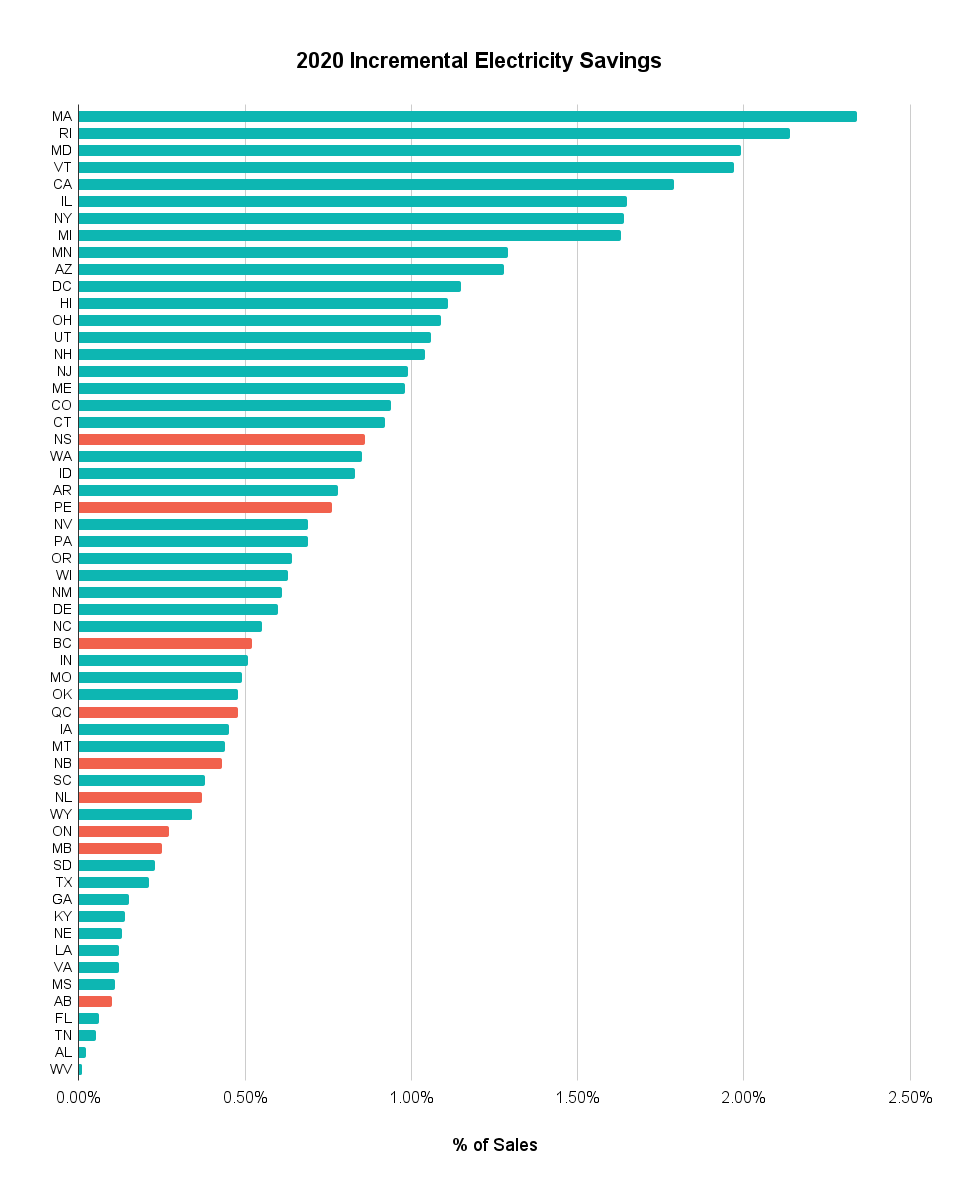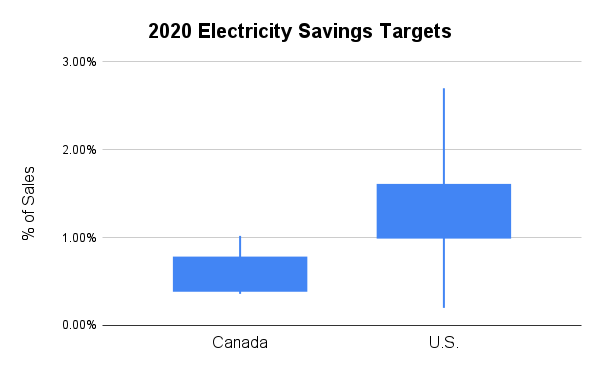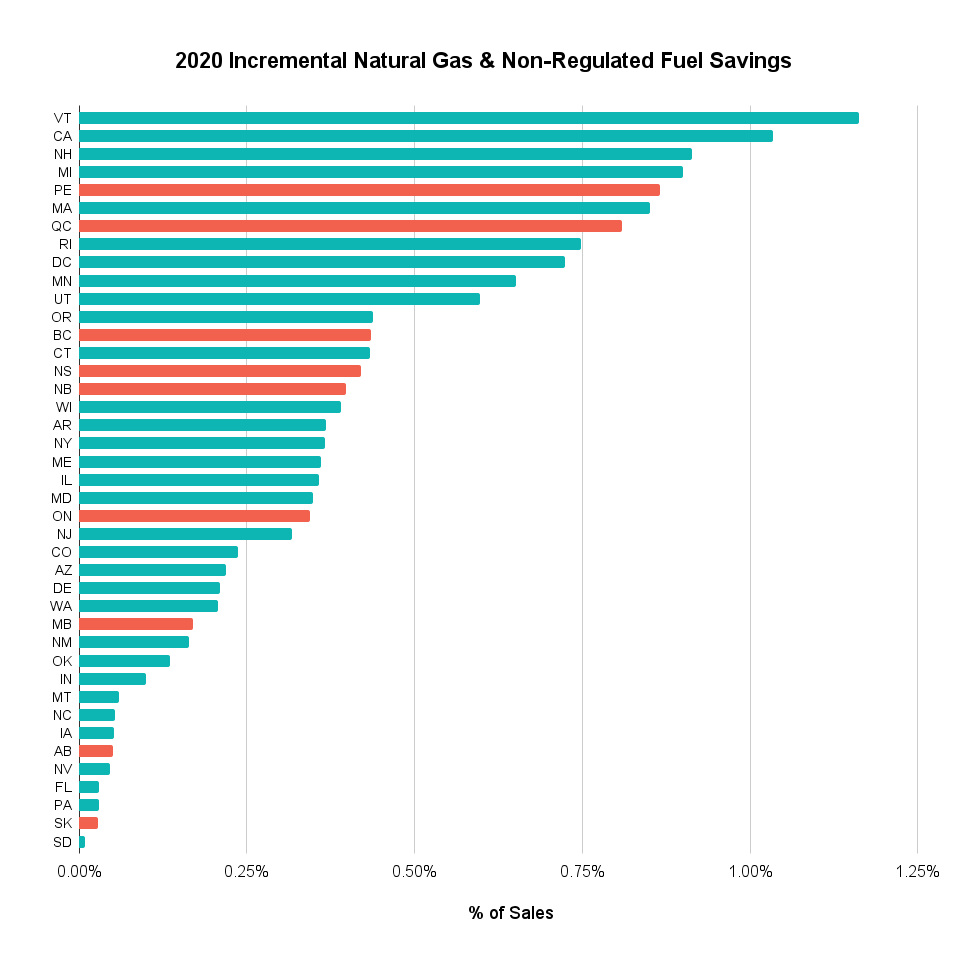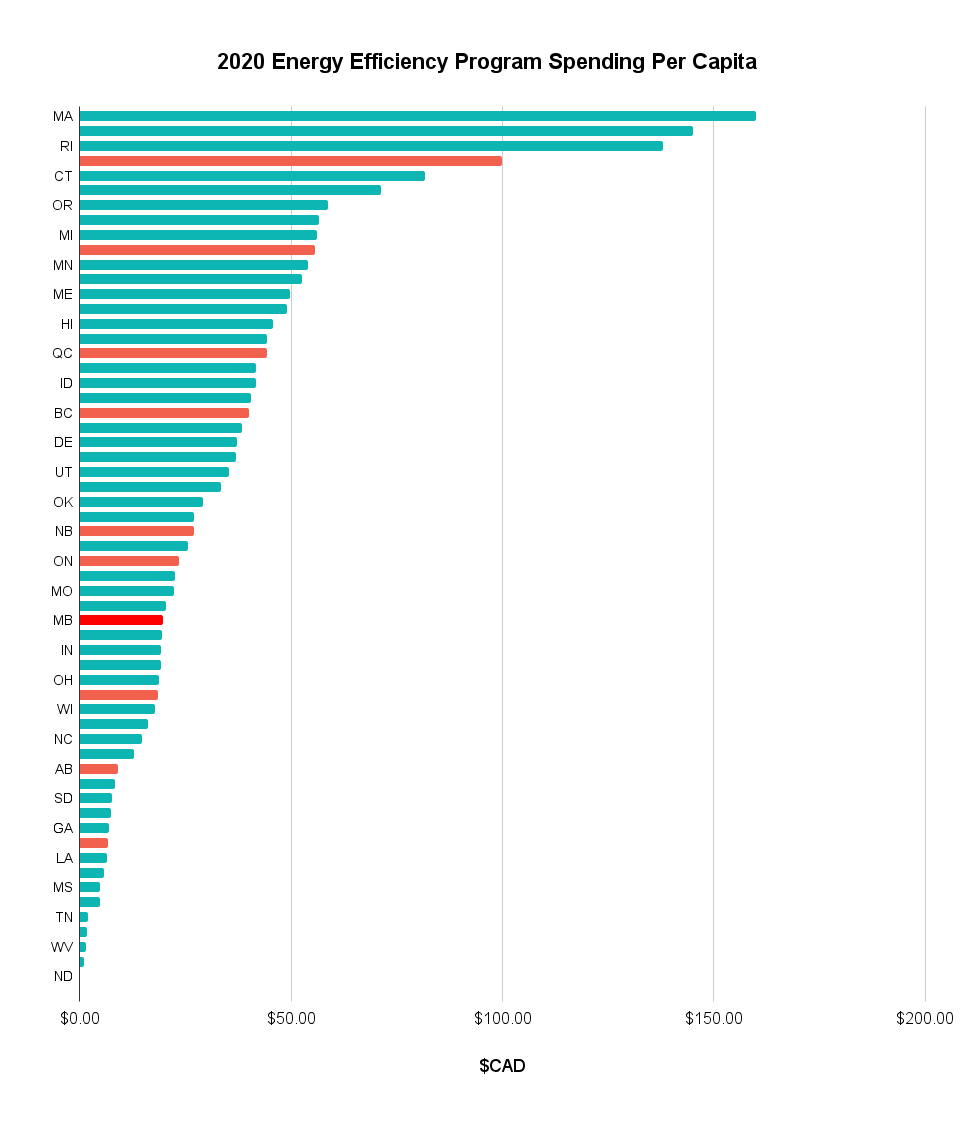Canada’s provinces lag leading American states in energy efficiency savings and spending
Policies like energy efficiency resource standards lead to higher savings performance south of the border
Alyssa Nippard
Research Associate, Efficiency Canada

Annabelle Linders

Brendan Haley
Director of Policy Research, Efficiency Canada

James Gaede

Abhi Kantamneni
May 25, 2022
Blogs | News | Provincial Policy
- New report compares energy efficiency savings, targets, and spending in Canada and the United States.
- Electricity targets are significantly higher in American states than Canadian provinces
- Canada is slightly higher in median per capita spending and fossil fuel program savings
Efficiency Canada’s latest report compares Canadian province and American state energy efficiency program savings and spending. We benchmarked metrics from the latest Canadian and United States energy efficiency scorecards:
- The 2021 Provincial Energy Efficiency Policy Scorecard, and
- The 2021 American Council for an Energy-Efficient Economy’s State Scorecard
This is our second benchmarking report (the first was published in 2020).
This blog walks you through the results and provides some policy context that explains why provinces continue to lag leading American states.
Note: The following data are annual results from programs operating in 2020, which is when the pandemic generally resulted in a decrease in both savings and spending. Net savings are compared across jurisdictions by dividing by relevant annual sales. Spending is compared per capita.
Here are the results!
Average vs. top jurisdictions
First, let’s look at the overall results. The median Canadian province has slightly higher fossil fuel savings and per capita spending levels than the median American state. However, Canada is far behind when you compare the top 30% of Canadian provinces and American states. American states are ahead in electricity savings performance and targets when comparing the median and the top jurisdictions.
- The top performer was Massachusetts, with 2.34% savings.
- Only two of the nine provinces that reported savings (Nova Scotia and Prince Edward Island) are in the top 50% of performers.
- While the top 15 states reached at least 1% savings, no province hit this level in 2020. Nova Scotia achieved 0.86% savings, and Prince Edward Island achieved 0.76% savings. All other provinces saved between 0.10% (Alberta) and 0.52% (BC).

- States have reported significantly higher savings targets than provinces. Nineteen states reported targets of 1% or higher. Only Nova Scotia, with 1.02%, reached this level of ambition. The remaining seven provinces had targets between 0.36% (New Brunswick) and 0.96% (Prince Edward Island).
- Looking at national medians, the American median of 1.2% is more than double the Canadian median of 0.48%.
- The highest target is Massachusetts, which aims to increase its annual electricity savings to 2.7%.
- The top 30% of states had a mean target of 1.91%, while the top 30% of provinces had a mean target of 0.99%.

Fossil fuel program savings
We get a slightly different picture with energy efficiency programs focused on saving fossil fuels. This includes natural gas and “non-regulated fuels” such as heating oil and propane. We compared savings across jurisdictions as a percentage of annual residential, commercial, and industrial sales/end-use demand.- Prince Edward Island and Québec rank in the top ten jurisdictions in North America with 0.87% and 0.81% savings, respectively.
- Vermont is the top jurisdiction with a savings of 1.16%.
- Canada was slightly ahead when comparing median savings, with the middle jurisdiction in Canada saving 0.4% (New Brunswick) and the middle American state saving 0.35% (Maryland).

Program spending
Program spending provides yet another indicator of the level of efficiency effort in each jurisdiction. This indicator helps control for any differences in energy saving evaluation methodologies or spending on areas that are more difficult to measure. Our spending metric is presented in Canadian dollars per capita. It includes program spending on all fuels and energy efficiency activities that might not result in measurable energy savings, such as education, marketing, and research.- American leaders in energy savings are also the top spenders. In 2020, the average per capita spending in the top three jurisdictions (Massachusetts, Vermont, and Rhode Island) was $147.72 per capita. The average spending of the top three performing Canadian provinces was $66.55 per capita.
- Prince Edward Island and Nova Scotia are among the top ten spending jurisdictions in North America. Prince Edward Island leads Canadian spending with $99.79 per capita, and Nova Scotia spends the second-most among Canadian provinces at $55.60 per capita.

Better policies, higher savings
A quick look at policies of Canadian provinces versus the leading American states demonstrates that policy drives higher energy efficiency programs savings and spending. The leading states establish aggressive, mandatory targets and work to align utility incentives with energy and greenhouse gas emission savings. The leading American states have “Energy efficiency resource standards” (EERS). These are mandatory, long-term targets for program savings. They often require an investment in energy efficiency resources that are more cost-effective than supply-side options. We also see similar targets in the European Union through the Energy Efficiency Directive, where an Energy Savings Obligation requires member states to achieve annual savings equal to 1.5% of final energy consumption. These resource standards are now evolving to cross fuels and promote GHG reductions. For instance, Massachusetts has complemented existing electricity and natural gas specific targets with a fuel neutral objective to enable strategic electrification. Likewise, Vermont’s existing three-year plan includes GHG reduction goals alongside traditional performance goals for electricity savings and equity. No province has clearly required utility regulators to capture “all cost-effective” energy efficiency in Canada. Mandatory existing targets do not encourage program savings significantly above business as usual. Nor does Canada have European Union-style energy savings targets for provinces.Electricity savings needed to support electrification
The comparative results show that Canadian provinces lag behind the states the most in annual electricity savings. Provinces like British Columbia and Quebec recently developed large hydroelectric dams that created electricity surpluses. In response, they have purposefully ramped down electricity savings. However, this picture is changing with net-zero goals, which require increased electrification of transportation and heating. Fuel switching towards energy efficient electric heat will increase the fossil fuel savings metrics we track. Yet, we need more electricity savings to free up clean energy resources to replace fossil fuels. Hydro-Quebec’s 2022-2026 strategic plan now aims to double its electricity savings targets to support the province’s electrification goals and promote exports. However, this increase will still put the province behind savings levels targeted by the bulk of leading American states. Other provinces have held back electricity savings, which needs to change to be compatible with a net-zero emission future. Ontario capped electricity savings budgets below what is cost-effective, and the latest outlook shows that electrification of transportation and industries like steel will significantly increase future demand. A new Electrification and Energy Transition Panel appointed by the Minister of Energy should look at the need for more electricity savings. British Columbia plans to ramp up electric demand-side management after following a “moderation approach” in recent years, yet a net-zero emissions future likely requires even higher savings. BC Hydro’s Integrated Resource Plan’s “accelerated electrification scenario” demonstrates the benefits of increasing electric energy efficiency above what is currently proposed. This will allow the province to meet its GHG reduction and electrification goals. Nova Scotia is a traditional leader in electricity savings. However, Nova Scotia Power’s 2021 Integrated Resource Plan did not include a long-term carbon price, and the government’s framework “environmental goals” legislation did not include an energy efficiency resource standard. With the benchmark carbon price moving to $170 per tonne, more electricity energy efficiency should be highly cost-effective. When many net-zero scenarios project significant increases in electricity demand, one of the easiest ways to manage this demand is to save more electricity. More electricity savings will ensure Canada’s clean electricity resources are used most productively. To build an electricity system that contributes to a net-zero emissions economy, electricity savings need to ramp up quickly. The sooner programs start saving kilowatt-hours, the more these savings accumulate over time and create a significant impact on energy demand in 2030 and beyond.Find your buddy!
Wondering how your province can improve on energy efficiency spending and saving? Check out what your “buddy” state is doing! We paired up a few provinces with a “buddy” state to examine policy differences. Below we compare results and policies in:- Ontario and New York
- British Columbia and California
- Nova Scotia and Vermont



Conclusion
Comparing the states and provinces provides a more comprehensive benchmarking than the Provincial Energy Efficiency Scorecard, especially when it comes to program savings. All Canadian provinces have some energy efficiency program activity, yet even Canada’s top spenders and savers are behind leading American states.
While Canada’s different energy systems and past planning decisions led to electricity surpluses, this context is changing. Now, Canada must prepare for widespread electrification.
Major differences between the states and provinces are explained by the policy. Leading American states have established clear energy efficiency resource standards that require targeting all cost-effective energy savings available. They also better align their utility business models and programs with energy efficiency and greenhouse gas emission reduction goals.
Looking at the entire North American context, we see that Canada’s top provinces continue to lag leading American states. Advocates like you can fill that gap!
Check out these resources to advocate for bolder energy efficiency policies in your jurisdiction:
- Read the full US/Canada Benchmarking Report
- Learn about Low-Income Energy Efficiency
- Join the energy efficiency community
- Download slides and social media graphics showing how your province compares to the top three states:

